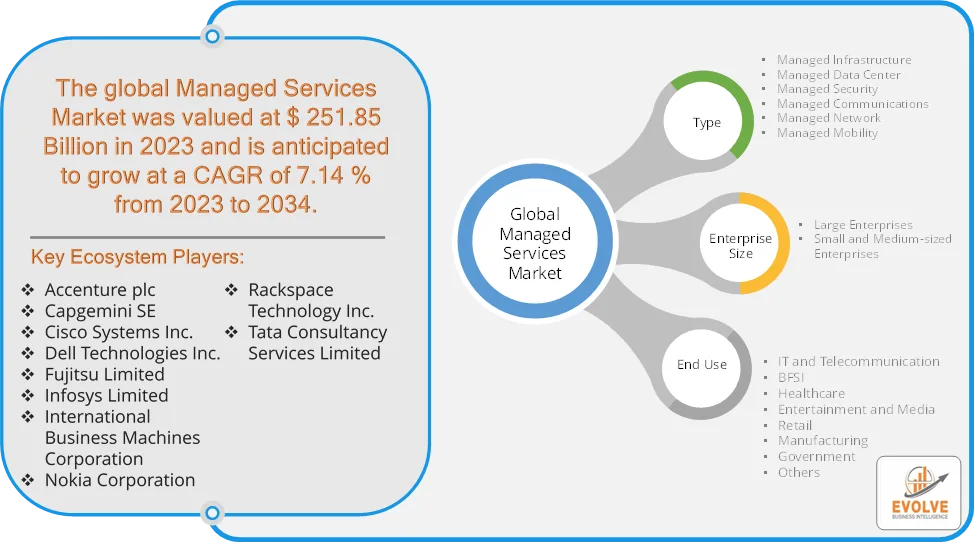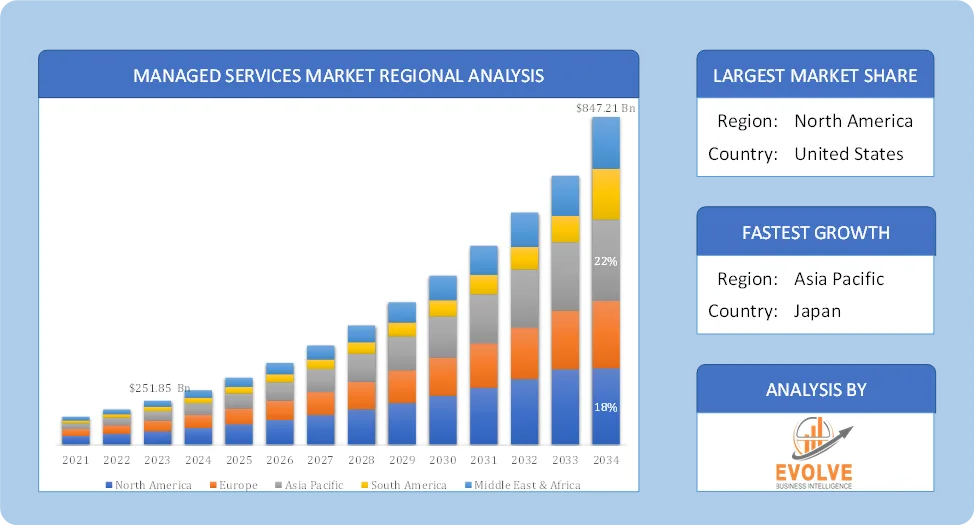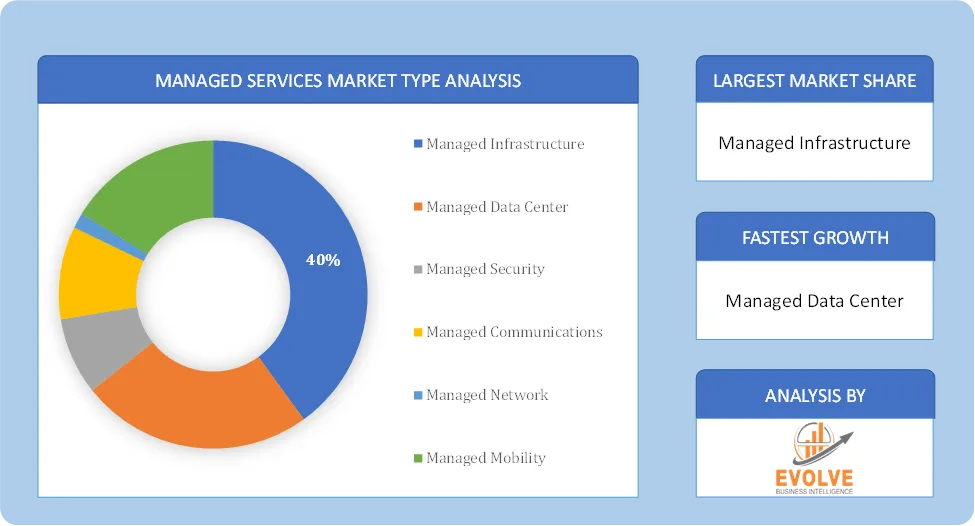Price range: $ 1,390.00 through $ 5,520.00
Managed Services Market Research Report: Information By Type (Managed Infrastructure, Managed Data Center, Managed Security, Managed Communications, Managed Network, Managed Mobility), By Enterprise Size (Large Enterprises, Small and Medium-sized Enterprises), End Use (IT and Telecommunication, BFSI, Healthcare, Entertainment and Media, Retail, Manufacturing, Government, and Others), and by Region — Forecast till 2034
Page: 165
Description
Managed Services Market Overview
The Managed Services Market size accounted for USD 251.85 Billion in 2023 and is estimated to account for 365.14 Billion in 2024. The Market is expected to reach USD 847.21 Billion by 2034 growing at a compound annual growth rate (CAGR) of 7.14% from 2024 to 2034. The Managed Services Market refers to the outsourcing of IT operations and business functions to third-party providers, enabling organizations to focus on core business activities while ensuring efficiency, cost savings, and enhanced security. Managed services cover a broad spectrum, including IT infrastructure management, cybersecurity, cloud services, network monitoring, and data analytics.
The Managed Services Market is expected to witness substantial growth due to the increasing reliance on outsourcing IT functions, the expansion of cloud-based services, and growing cybersecurity needs. The integration of AI and automation will further enhance service delivery, making managed services indispensable for enterprises globally.
Global Managed Services Market Synopsis
 Managed Services Market Dynamics
Managed Services Market Dynamics
The major factors that have impacted the growth of Managed Services Market are as follows:
Drivers:
Ø Increasing IT Complexity & Digital Transformation
Businesses are adopting emerging technologies like cloud computing, AI, IoT, and big data, leading to complex IT environments. Organizations outsource IT management to reduce operational burdens and ensure seamless integration of new technologies. Managed services offer a cost-effective alternative to maintaining an in-house IT team. The increasing frequency of cyberattacks, data breaches, and ransomware drives demand for managed security services (MSSPs). The rise of remote and hybrid work models has increased demand for managed IT support, secure VPNs, and collaboration tools and Organizations rely on MSPs to maintain secure access to enterprise applications and networks.
Restraint:
- High Initial Setup Costs and Privacy Concerns
Transitioning to managed services requires significant upfront investment in IT infrastructure, training, and migration processes. Small and medium-sized enterprises (SMEs) may find it cost-prohibitive to adopt managed services initially. Organizations are hesitant to share sensitive business data with third-party service providers due to the risk of data breaches and cyber threats. Businesses with limited IT knowledge may struggle to assess and integrate managed service providers (MSPs) effectively and Misalignment between business objectives and MSP service offerings can lead to operational inefficiencies.
Opportunity:
⮚ Rising Demand for Cloud-Based Managed Services
Businesses are increasingly adopting hybrid and multi-cloud environments, creating a strong need for cloud management services. Managed cloud security, cost optimization, and migration services present lucrative opportunities for MSPs. AI-powered predictive analytics, automation, and IT service management (ITSM) solutions are gaining traction. Growing cyber threats, ransomware attacks, and regulatory compliance requirements are driving demand for managed security services and Businesses seek endpoint security, SIEM (Security Information and Event Management), and threat intelligence solutions from MSPs.
Managed Services Market Segment Overview
Based on Type, the market is segmented based on Managed Infrastructure, Managed Data Center, Managed Security, Managed Communications, Managed Network, Managed Mobility. The Managed Infrastructure segment dominant the market. Managed infrastructure services encompass the outsourcing of IT infrastructure components such as servers, storage, and networking equipment to third-party providers. Managed infrastructure services offer benefits such as improved reliability, scalability, and performance, enabling organizations to focus on core business activities while leveraging the expertise of service providers to maintain and support their IT infrastructure.
By Enterprise Size
Based on Source, the market segment has been divided into Large Enterprises, Small and Medium-sized Enterprises. The large enterprises segment dominant the market. It characterized by extensive IT infrastructure, complex operations, and significant budget allocations for IT services. These organizations often require a wide range of managed services to support their diverse business needs, including network management, cybersecurity, data analytics, and cloud computing.
By End Use
Based on End user, the market segment has been divided into IT and Telecommunication, BFSI, Healthcare, Entertainment and Media, Retail, Manufacturing, Government, and Others. The IT and Telecommunication segment dominant the managed services market, driven by the constant need for reliable IT infrastructure and communication networks. Managed service providers in this segment offer a wide range of services, including network management, data center services, cloud computing, cybersecurity, and communication solutions.
Global Managed Services Market Regional Analysis
Based on region, the global Managed Services Market has been divided into North America, Europe, Asia-Pacific, the Middle East & Africa, and Latin America. North America is projected to dominate the use of the Managed Services Market followed by the Asia-Pacific and Europe regions.
 North America Managed Services Market
North America Managed Services Market
North America holds a dominant position in the Managed Services Market. It’s attributed to its early adoption of advanced technologies and a well-established IT infrastructure. The presence of numerous Managed Service Providers (MSPs), including industry leaders like IBM Corporation and Accenture, bolsters the market. The United States, in particular, demonstrates significant growth due to the rising adoption of these services among small and medium-sized enterprises and substantial IT budgets allocated to managed services.
Asia-Pacific Managed Services Market
The Asia-Pacific region has indeed emerged as the fastest-growing market for the Managed Services Market industry. It’s driven by rapid digitization, improving IT infrastructure, and increasing adoption of cloud technologies. Countries like China, India, and Japan are at the forefront, supported by government initiatives promoting digital transformation and cybersecurity measures. The growing presence of SMEs, coupled with their increasing awareness of the benefits of outsourcing IT operations, is fueling market demand.
Competitive Landscape
The global Managed Services Market is highly competitive, with numerous players offering a wide range of software solutions. The competitive landscape is characterized by the presence of established companies, as well as emerging startups and niche players. To increase their market position and attract a wide consumer base, the businesses are employing various strategies, such as product launches, and strategic alliances.
Prominent Players:
- Accenture plc
- Capgemini SE
- Cisco Systems Inc.
- Dell Technologies Inc.
- Fujitsu Limited
- Infosys Limited
- International Business Machines Corporation
- Nokia Corporation
- Rackspace Technology Inc.
- Tata Consultancy Services Limited.
Key Development
In March 2024, Dell Technologies and CrowdStrike announced an expanded strategic partnership to deliver Dell’s Managed Detection and Response (MDR) services with the industry-leading AI-native CrowdStrike Falcon XDR platform, helping customers defend against increasingly complex cyberattacks.
Scope of the Report
Global Managed Services Market, by Type
- Managed Infrastructure
- Managed Data Center
- Managed Security
- Managed Communications
- Managed Network
- Managed Mobility
Global Managed Services Market, by Enterprise Size
- Large Enterprises
- Small and Medium-sized Enterprises
Global Managed Services Market, by End Use
- IT and Telecommunication
- BFSI
- Healthcare
- Entertainment and Media
- Retail
- Manufacturing
- Government
- Others
Global Managed Services Market, by Region
- North America
- US
- Canada
- Mexico
- Europe
- UK
- Germany
- France
- Italy
- Spain
- Benelux
- Nordic
- Rest of Europe
- Asia Pacific
- China
- Japan
- South Korea
- Indonesia
- Austalia
- Malaysia
- India
- Rest of Asia Pacific
- South America
- Brazil
- Argentina
- Rest of South America
- Middle East & Africa
- Saudi Arabia
- UAE
- Egypt
- South Africa
- Rest of Middle East & Africa
| Parameters | Indicators |
|---|---|
| Market Size | 2034: USD 847.21 Billion |
| CAGR (2024-2034) | 7.14% |
| Base year | 2022 |
| Forecast Period | 2024-2034 |
| Historical Data | 2021 (2017 to 2020 On Demand) |
| Report Coverage | Revenue Forecast, Competitive Landscape, Growth Factors, and Trends |
| Key Segmentations | Type, Enterprise Size and End Use |
| Geographies Covered | North America, Europe, Asia-Pacific, South America, Middle East, Africa |
| Key Vendors | Accenture plc, Capgemini SE, Cisco Systems Inc., Dell Technologies Inc., Fujitsu Limited, Infosys Limited, International Business Machines Corporation, Nokia Corporation, Rackspace Technology Inc. and Tata Consultancy Services Limited. |
| Key Market Opportunities | · Rising Demand for Cloud-Based Managed Services
· Increasing Adoption of Managed Security Services (MSSP) |
| Key Market Drivers | · Increasing IT Complexity & Digital Transformation
· Rising Cybersecurity Threats |
REPORT CONTENT BRIEF:
- High-level analysis of the current and future Managed Services Market trends and opportunities
- Detailed analysis of current market drivers, restraining factors, and opportunities in the future
- Managed Services Market historical market size for the year 2021, and forecast from 2023 to 2033
- Managed Services Market share analysis at each product level
- Competitor analysis with detailed insight into its product segment, Government & Defense strength, and strategies adopted.
- Identifies key strategies adopted including product launches and developments, mergers and acquisitions, joint ventures, collaborations, and partnerships as well as funding taken and investment done, among others.
- To identify and understand the various factors involved in the global Managed Services Market affected by the pandemic
- To provide a detailed insight into the major companies operating in the market. The profiling will include the Government & Defense health of the company’s past 2-3 years with segmental and regional revenue breakup, product offering, recent developments, SWOT analysis, and key strategies.
Frequently Asked Questions (FAQ)
What is the growth rate of the global Managed Services Market?
The global Managed Services Market is growing at a CAGR of 7.14% over the next 10 years
Which region has the highest growth rate in the market of Managed Services Market?
Asia Pacific is expected to register the highest CAGR during 2024-2034
Which region has the largest share of the global Managed Services Market?
North America holds the largest share in 2022
Who are the key players in the global Managed Services Market?
Accenture plc, Capgemini SE, Cisco Systems Inc., Dell Technologies Inc., Fujitsu Limited, Infosys Limited, International Business Machines Corporation, Nokia Corporation, Rackspace Technology Inc. and Tata Consultancy Services Limited. are the major companies operating in the market.
Do you offer Post Sale Support?
Yes, we offer 16 hours of analyst support to solve the queries
Do you sell particular sections of a report?
Yes, we provide regional as well as country-level reports. Other than this we also provide a sectional report. Please get in contact with our sales representatives.
Additional information
| Packages | Single User License, Enterprise License, Data Pack Excel |
|---|



